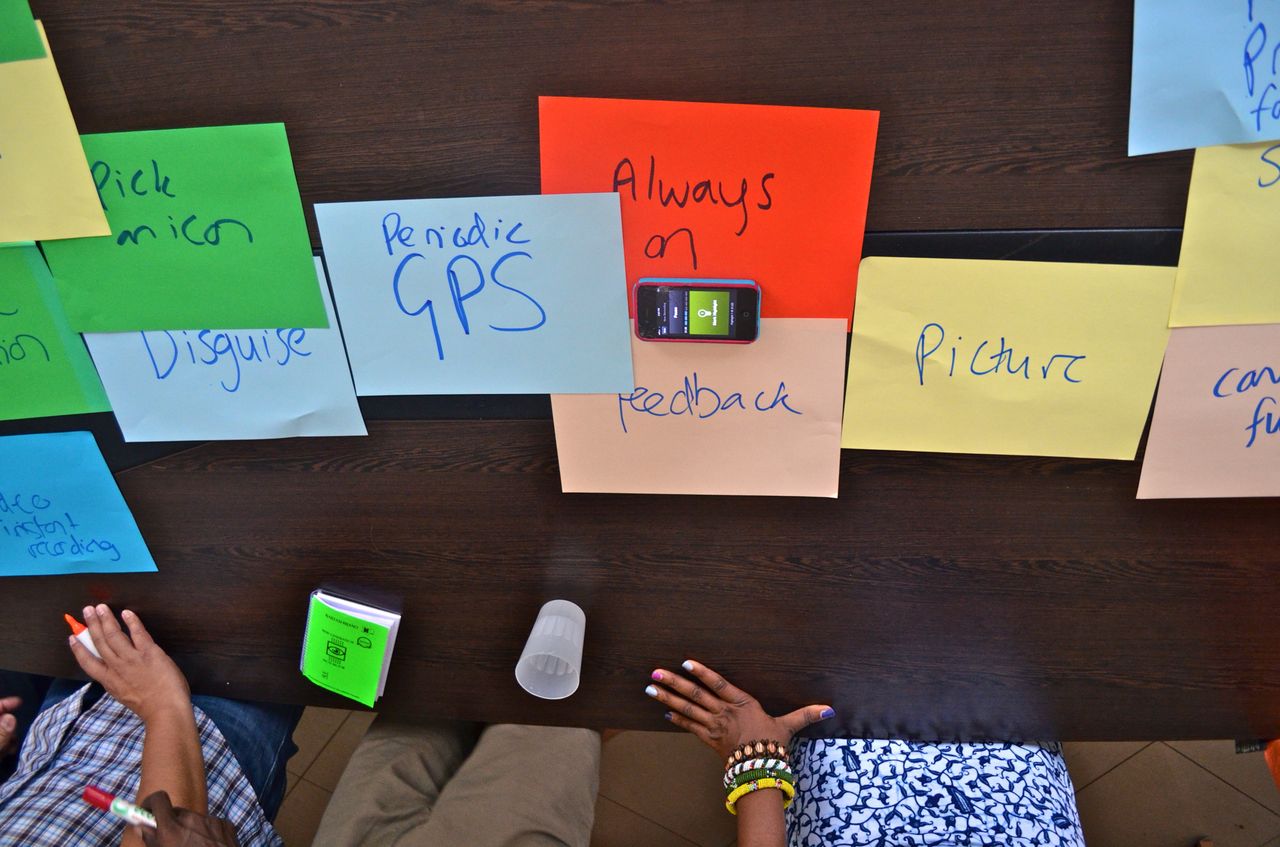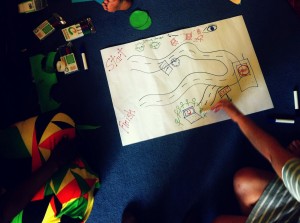
Activists create a visual agenda for a week of workshops focused on using technology in human rights work (Photo Credit: Amnesty International).
By Tanya O’Carroll, Technology & Human Rights Project Officer at Amnesty International
When Amnesty was founded 50 years ago, our tool of choice was the pen. Thousands would write letters to governments demanding the release of Prisoners of Conscience. Pen and paper helped release human rights advocates in many countries around the world.
New technologies – such as social media and mobile Internet – have fundamentally changed how we shed light on and respond to human rights abuses. Today, almost anyone with a mobile phone can be a human rights monitor and challenge the abuse of power by capturing and sharing documentation of abuses as they happen.

Amnesty International USA Poster, 1990. A letter is one of the most elementary ways to express an opinion (Photo Credit: Amnesty International).
And yet, technology brings new threats. Information Communication Technologies (ICTs) are becoming a battleground as journalists, citizens and activists seek inventive ways to protect the secure flow of information while governments invest in sophisticated technologies to intercept, monitor, track and censor those who challenge them.
The Technology and Human Rights project at Amnesty’s International Secretariat in London focuses on how as an organization we leverage technology to do what we’ve always done, but better: to respond and react when individuals around the world are under threat.
Imagining New Kinds of Solutions
For the past year-and-a-half, I’ve been working on Panic Button, a mobile app for Android that aims to turn an activist’s mobile phone into an emergency alert system (read more about the project here and check out our video as finalists in the Google Global Impact Challenge).
Panic Button was the product of an open design process that we kicked off with OpenIDEO in early 2012. I have been amazed at how many people along the way have devoted their spare time and talents to the simple but transformational idea of creating a mobile alert system for activists. The project has closely involved 648 challenge participants, more than 50 Designers, 30 Activists and 18 Developers since then.
Open design is all about imagination. It’s about working with “makers” and “do-ers” to help us think differently about traditional challenges we face in our work. A recent example was #FreedomHack (check out my colleague Katie’s write up). With feedback from journalists in Mexico, a team of developers created a new ‘Guardian feature’ for Panic Button to broadcast messages should a user not respond to prompts within a given time frame.
This is a breakthrough feature that creates a whole new use-case for the application, facilitating not just proactive but reactive alerts when an individual is attacked.
And that’s just the start. We have no shortage of imagination.
Imagine one day if every mobile phone – not just a smartphone – could serve as a personal alert device for those who defend human rights. Imagine if, at the touch of a button, the alert could transmit not just location but a live video recording of what is happening. Imagine if it could ‘shut down’ email and social media accounts, helping to protect an individual’s wider communications and network from being compromised.
The technology to make this a reality is very much within reach. We’ve already been investigating what it would take to replicate the ‘one touch’ panic feature on a basic handset. Activists have been live video streaming from mobile for at least a couple of years. Meanwhile projects such as KillPacket are already working out how an SMS from a mobile phone might remotely close down private email and social media accounts.
From Ideation to Implementation
There is no shortage of good will and good ideas when it comes to building tools for activists. The challenge now is to see safe and relevant tools being widely used.

Activists brainstorm and prioritise some of the potential features for ‘Panic Button’ in an open design workshop in Nairobi (Photo Credit: Amnesty International).
We need to start imagining less of the technology and more of the human networks that are needed to create scalability and sustainability.
The idea of the permanent hackathon, indicates what may be possible when we invest in those ongoing structures and spaces for collaboration. That includes asking the difficult questions about who and how we work together. Are some organizations better placed to focus on development, others on testing and training? How do we attract the level of investment needed to sustain these kinds of joint initiatives?
We are so excited to hear from our partners CommunityRED and Factual in Mexico that a November follow up to the #FreedomHack will focus less on generating new ideas and more on developing existing tools. This is the beginning of a network in Mexico that sees cooperation as the only way we can create lasting projects that serve the communities they are designed for.
After all, without people, technology offers few solutions.
Over the next couple of months, we will be keeping you posted about Panic Button on this blog, and also filling you in on a number of other projects and collaborations in the making. In the meantime, we want to hear from you! If you want to join the community of people working on Panic Button, please reach out to us and we’ll let you know of ways you can get involved! Email: [email protected].
This is the second post of a series: “Technology for Human Rights Protection” with new entries being published every week or so. We will be discussing the latest innovations for human rights protection and how the human rights community is or can be utilizing science, technology and open innovation for human rights defense. Posts primarily by @katiestriff and @tanyaocarroll, who work in the intersection between technology, science and human rights defense for @Amnesty and @amnestyonline, with the occasional colleague and guest contributor.
So when's the app coming out? An estimated release date?
What kind of app? Anorid or Apple
Thanks for sharing this amazing article.
Sounds really cool.The idea is simple: the app changes a smart phone into a mystery alarm that can ready companions and partners that the client is in a bad position –for example,under assault or going to be capture.Have a nice day.
Kate Rios.
Seems good. This is amazing and helpful post. Thanks for sharing this post.
Excellent app you have shared, thank you and keep up the good work.
http://www.syriatalk.me/
thank you for the information
d o it
that looks pretty interesting though lucky patcher app download
awesome info i found. Thanks for this information. Vidmate
thanks admin for sharing such a pretty information through this nice post. great addition.
very very thanks for sharing with us and keep sharing with us.
Android is the open source operating system by Google. Since 2008, it has become the most preferred alternative to conventional operating systems especially when it comes to mobile devices.
Such kind education is more effective for the people and i think the young guys are be motivated to invention the more new apps. In this education we find more better science to developed the world communication.
nice post, thanks for sharing
i really thank for sharing for this post android is the one of the best applecation of the world
Great post. Thanks for sharing…
Nice one.
Excellent post.
thanks for your sharing..
جوجل بلاي
That’s a big advantage! The ability to access your team board any time, anywhere from a mobile device enables you to contribute ideas whenever they strike you, before you forget about them.
Brilliant post. Keep it up.
Awesome post.
Thanks for the insightful explanation. And thanks for allowing comments too. iPhone App Developer Company Los Angeles & San Francisco
thanks
Nice post.
Wonderful post.
Great job keep it up Admin
Interesting information share.
Nice.
Nice post
A good site with exciting content that is what I need. Thank you for making this web site, and I will be visiting again. It is really resourceful blog with great content.